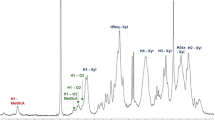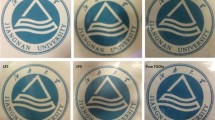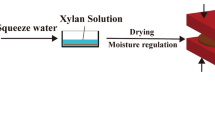Abstract
Recently, growing interests have been focused on biodegradable films from natural macromolecule, especially great efforts have been made to prepare composite films of xylan with other polymers to improve mechanical properties. In this work, we developed composite films of polyvinyl alcohol (PVA)/xylan with enhanced mechanical properties, the high hydrophobicity and the high UV shielding performance by an addition of TiO2. Influences of different crystal forms of TiO2 on the functional properties of composites films such as hydrophilicity/hydrophobicity, water vapor permeability, mechanical properties, solubility and UV transmittance were comparatively investigated. SEM and TGA were used to characterize the morphology and thermal stability of composite films. Results showed that rutile TiO2 could greatly improve the mechanical properties such as tensile strength (TS). When the amounts of rutile TiO2 and glycerol was 2 and 10 % based on the weight of PVA and xylan, TS reached to 30.73 MPa and the elongation at break (EAB) was 192.9 %, correspondingly to 115.5° of contact angle for PVA/xylan composite films. PVA/xylan composite films containing TiO2 had the high UV shielding performance. Therefore, these composite films with excellent properties could have the promising application for food and fruit packaging as preservative films.






Similar content being viewed by others
References
Alekhina M, Mikkonen KS, Alen R, Tenkanen M, Sixta H (2014) Carboxymethylation of alkali extracted xylan for preparation of bio-based packaging films. Carbohydr Polym 100:89–96
Bayati F, Boluk Y, Choi P (2014) Diffusion behavior of water at infinite dilution in hydroxypropyl xylan films with sorbitol and cellulose nanocrystals. ACS Sustain Chem Eng 2:1305–1311
Dammström S, Salmén L, Gatenholm P (2005) The effect of moisture on the dynamical mechanical properties of bacterial cellulose/glucuronoxylan nanocomposites. Polymer 46:10364–10371
Deutschmann R, Dekker RFH (2012) From plant biomass to bio-based chemicals: latest developments in xylan research. Biotechnol Adv 30:1627–1640
Escalante A, Goncalves A, Bodin A, Stepan A, Sandstrom C, Toriz G, Gatenholm P (2012) Flexible oxygen barrier films from spruce xylan. Carbohydr Polym 87:2381–2387
Fox MA, Dulay MT (1993) Heterogeneous photocatalysis. Chem Rev 93:341–357
Gabrielii I, Gatenholm P, Glasser WG, Jain RK, Kenne L (2000) Separation, characterization and hydrogel-forming of hemicellulose from aspen wood. Carbohydr Polym 43:367–374
Gröndahl M, Eriksson L, Gatenholm P (2004) Material properties of plasticized hardwood xylans for potential application as oxygen barrier films. Biomacromolecules 5:1528–1535
Hansen NML, Blmfeldt TOJ, Hedenqvist MS, Plackett DV (2012) Properties of plasticized composite films prepared from nanofibrillated cellulose and birch wood xylan. Cellulose 19:2015–2031
Heikkinen SL, Mikkonen KS, Pirkkalainen K, Serimaa R, Joly C, Tenkanen M (2013) Specific enzymatic tailoring of wheat arabinoxylan reveals the role of substitution on xylan film properties. Carbohydr Polym 92:733–740
Hoffman MR, Martin ST, Choi W, Bahnemann DW (1995) Environmental applications of semiconductor photocatalysis. Chem Rev 95:69–96
Kayserilioglu BS, Bakir U, Yilmaz L, Akkas N (2003) Use of xylan, an agricultural by-product, in wheat gluten based biodegradable films: mechanical, solubility and water vapor transfer rate properties. Bioresource Technol 87:239–246
Khanna PK, Singh N, Charan S (2007) Synthesis of nano-particles of anatase TiO2 and preparation of its optically transparent film in PVA. Mater Lett 61:4725–4730
Kubacka A, Serrano C, Ferrer M, Lunsdorf H, Bielecki P, Cerrada MAL, Fernandez-Garcia M, Fernandez-Garcia M (2007) High-performance dual-action polymer–TiO2 nanocomposite films via melting processing. Nano Lett 7:2529–2534
Li YT, Sun XG, Li HW, Wei Y (2009) Highly stable re-dispersibility of nanocrystalline TiO2 observed during anatase-rutile phase transformation. Phys Status Solidi 206:1520–1524
Li F, Hao XH, Wang ZZ, Li HM (2010) Performance research of PVA/TiO2 compound film by solution casting. Pack J 2:67–70
Mikkonen KS, Tenkanen M (2012) Sustainable food-packaging materials based on future biorefinery products: xylans and mannans. Trends Food Sci Technol. doi:10.1016/j.tifs.2012.06.012
Mikkonen KS, Heikkinen S, Soovre A, Peura M, Serimaa R, Talja RA, Helén H, Hyvönen L, Tenkanen M (2009) Films from oat spelt arabinoxylan plasticized with glycerol and sorbitol. J Appl Polym Sci 114:457–466
Mikkonen KS, Pitkänen L, Liljeström V, Bergström EM, Serimaa R, Salmén L, Tenkanen M (2012) Arabinoxylan structure affects the reinforcement of films by microfibrillated cellulose. Cellulose 19:467–480
Patel AK, Bajpai R, Keller JM (2014) On the crystallinity of PVA/palm leaf biocomposite using DSC and XRD techniques. Microsyst Technol 20:41–49
Peng F, Ren JL, Xu F, Bian J, Peng P, Sun RC (2009) Comparative study of hemicelluloses obtained by graded ethanol precipitation from sugarcane bagasse. J Agric Food Chem 57:6305–6317
Peng XW, Ren JL, Zhong LX, Sun RC (2011) Nanocomposite films based on xylan-rich hemicelluloses and cellulose nanofibres with enhanced mechanical properties. Biomacromolecules 12:3321–3329
Peresin MS, Kammiovirta K, Setala H, Tammelin T (2012) Structural features and water interactions of etherified xylan thin films. J Polym Environ 20:895–904
Ren JL, Sun RC (2010) Hemicelluloses. In: Sun RC (ed) Cereal straw as a resource for sustainable biomaterials and biofuels. Elsevier, Amsterdam, pp 73–130
Samir A, Alloin F, Dufresne A (2005) A review of recent research into cellulosic whiskers, their properties and their application in nanocomposite field. Biomacromolecules 6:612–626
Saxena A, Ragauskas AJ (2009) Water transmission barrier properties of biodegradable films based on cellulosic whiskers and xylan. Carbohydr Polym 78:357–360
Saxena A, Elder TJ, Pan S, Ragauskas AJ (2009) Novel nanocellulosic xylan composite film. Compos Part B-Eng 40:727–730
Saxena A, Elder TJ, Kenvin J, Ragauskas A (2010) High oxygen nanocomposite barrier films based on xylan and nanacrystalline cellulose. Nano-Micro Lett 2:235–241
Saxena A, Elder TJ, Ragauskas AJ (2011) Moisture barrier properties of xylan composite films. Carbohydr Polym 84:1371–1377
Simkovic I, Gedeon O, Uhliarikova I, Mendichi R, Kirschnerova S (2011) Xylan sulphate films. Carbohydr Polym 86:214–218
Simkovic I, Tracz A, Kelnar I, Uhliarikova I, Mendichi R (2014) Quaternized and sulfated xylan derivative films. Carbohydr Polym 99:356–364
Sreekumar P, Al-Harthi MA, De S (2012) Reinforcement of starch/polyvinyl alcohol blend using nano-titanium dioxide. J Compos Mater 46:3181–3187
Stevanic JS, Joly C, Mikkonen KS, Pirkkalainen K, Serimaa R, Remond C, Toriz G, Gatenholm P, Tenkanen M, Salmen L (2011) Bacterial nanacellulose-reinforced arabinoxylan films. J Appl Polym Sci 122:1030–1039
Wang SY, Ren JL, Kong WQ, Gao CD, Liu CF, Peng F, Sun RC (2014a) Influence of urea and glycerol on functional properties of biodegradable PVA/xylan composite films. Cellulose 21:495–505
Wang SY, Ren JL, Li WY, Sun RC, Liu SJ (2014b) Properties of polyvinyl alcohol/xylan composite films with citric acid. Carbohydr Polym 103:94–99
Zhang P, Whistler RL (2004) Mechanical properties and water vapor permeability of thin film from corn hull arabinoxylan. J Appl Polym Sci 93:2896–2902
Zhou XD, Zhu P, Zhang JB (2008) Preparation and properties of cellulose/TiO2 nano-particles anti-bacterial composite films. Text Dyeing Finish J 30:6–8
Acknowledgments
This work was supported by Grants from the Author of National Excellent Doctoral Dissertations of China (201169) and National Natural Science Foundation of China (No. 21406080), the Opening Project of State Key Laboratory of Pulp and Paper Engineering, South China University of Technology (201428) and the Fundamental Research Funds for the Central Universities (2014ZG0003), SCUT.
Author information
Authors and Affiliations
Corresponding authors
Rights and permissions
About this article
Cite this article
Ren, J., Wang, S., Gao, C. et al. TiO2-containing PVA/xylan composite films with enhanced mechanical properties, high hydrophobicity and UV shielding performance. Cellulose 22, 593–602 (2015). https://doi.org/10.1007/s10570-014-0482-1
Received:
Accepted:
Published:
Issue Date:
DOI: https://doi.org/10.1007/s10570-014-0482-1




